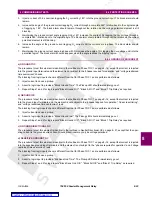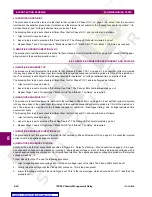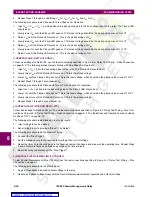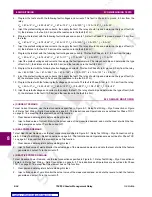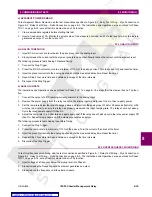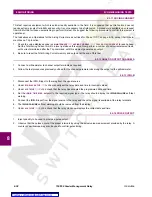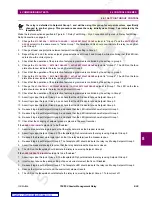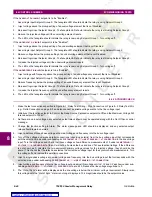
8-36
750/760 Feeder Management Relay
GE Multilin
8.5 MONITORING
8 COMMISSIONING TESTS
8
The following procedure checks the Overfrequency monitoring Timing:
1.
Connect the Stop Trigger.
2.
Preset the voltage source frequency to a minimum of 110% of pickup. Turn voltage off and reset the timer.
3.
Inject the preset voltage into phase A and note the measured delay time. Reset the timer.
4.
Repeat Step 3 four more times and obtain an average of the time intervals.
5.
Disconnect the “Stop Trigger".
8.5.6 POWER FACTOR
To test Power Factor monitoring, use the test connections specified in Figure 8–1: Relay Test Wiring – Wye Connection or
Figure 8–2: Relay Test Wiring – Delta Connection on page 8–3. The Indications and Operations are as outlined for Phase
TOC 1 on page 8–16, except that this element has no Trip function.
The following procedure checks Minimum Operating Voltage/Current Supervision:
1.
Inject fixed values of voltage and current at about nominal values, at unity power factor. Slowly increase the lagging
current angle, waiting for a time longer than the delay before each adjustment, until the element generates an output.
2.
Slowly reduce voltage
V
a
magnitude until the power factor feature resets. Note the dropout voltage, which should be at
about 30% of the selected nominal voltage. Return
V
a
to nominal.
3.
Repeat Step 2 for
V
b
.
4.
Repeat Step 2 for
V
c
.
5.
Slowly reduce
I
a
and
I
b
magnitude to 0. The power factor feature should remain operated.
6.
Slowly reduce
I
c
magnitude to 0. The power factor feature should reset.
7.
Return
I
a
to nominal. The power factor feature should operate again. Return
I
b
and
I
c
to nominal.
8.
Decrease the angle of lagging (balanced) current until the feature drops-out and resets the output relays.
The following procedure checks Power Factor Timing:
1.
Connect the Stop Trigger.
2.
Preset the 3-phase voltage and current inputs to a power factor more lagging than the pickup level. Turn voltages and
currents off, and reset the timer.
3.
Inject the preset voltage and current and note the measured delay time. Reset the timer.
4.
Repeat step 3 four more times and obtain an average of the time intervals.
5.
Disconnect the “Stop Trigger".
8.5.7 VT FAILURE
To test VT Failure monitoring, use the test connections specified in Figure 8–1: Relay Test Wiring – Wye Connection or Fig-
ure 8–2: Relay Test Wiring – Delta Connection on page 8–3.
1.
Set
V
an
=
V
bn
=
V
cn
= nominal voltage at 0°, 120°, and 240° respectively, and inject into the relay. With these balanced
voltages 120° apart, the positive sequence voltage (
V
1
) is greater than 0.05 x VT.
2.
Set
I
a
=
I
b
=
I
c
= 1 x CT at 0°, 120°, and 240° respectively, and inject into the relay. With these balanced currents 120°
apart, the positive sequence current (
I
1
) is greater than 0.05 x CT.
3.
Remove the balanced voltages so the positive sequence voltage (
V
1
) is less than 0.05 x VT. If this function is set to
“Control”, any output relays programmed for this condition should operate. If the function is set to “Alarm”, check that
the Alarm and Message LEDs are flashing, the VT Failure alarm message is displayed, and any output relays pro-
grammed for this condition are operated.
4.
Apply the balanced voltages and the VT Failure condition should reset.


